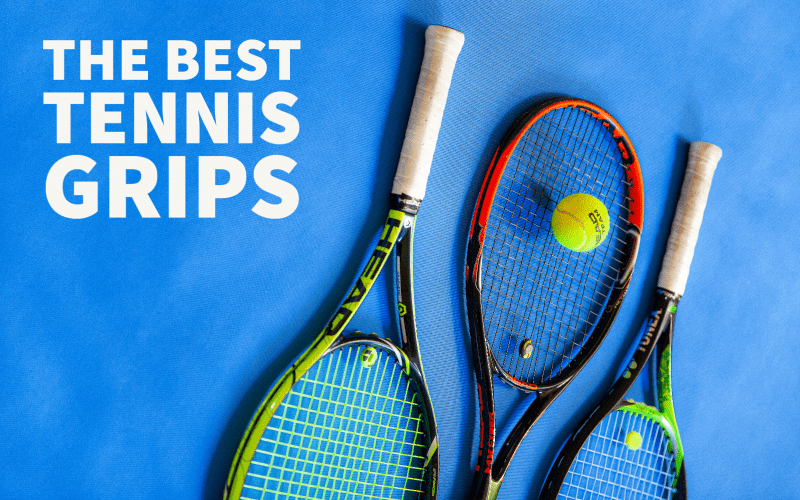If you ask anyone who plays tennis regularly what they consider to be the most important item of equipment, they might mention their racket frame, their string, or even their shoes. It is very unlikely that their racket grip will be among the first things they think of.
Nonetheless, it is absolutely vital that you have a firm and comfortable grip on your racket if you wish to be able to control the ball. A professional will always start a match with a brand new grip to make sure that the racket does not slip in their hands, and some, like Richard Gasquet, will apply a new overgrip at almost every change of ends.
Of course, everyone has different preferences and physical characteristics, and hence will need different types of grip, but in this article we will attempt to identify some of the best, considering both overgrips and replacements for the original grip.
Choosing the best tennis grip depends on whether a player has sweaty hands, prone to blisters, or who have dry hands. Some will be particularly keen on a comfortable grip. It is crucial to replace a grip before it deteriorates too much, in order to ensure that the grip is performing well.
Best Tennis Grips For Sweaty Hands
If you have sweaty hands, many racket grips will quickly become slippery during play. What might feel pleasantly tacky when first applied will often soon feel greasy and slippery. Some players find this so much of a problem that they lose their grip on the racket when serving, which can be slightly embarrassing.
The most popular solution for tennis players with sweaty hands is offered by overgrips which initially feel dry, but which become grippier when damp. Tourna Grip Original Dry Feel overgrips have been big sellers for many years, and is our best recommendation for players with sweaty hands.
These famously become grippier as they absorb sweat. If you do not like overgrips, there are replacement grips with ridges and/or perforations which can prevent your hand from slipping and absorb moisture. A good example of this is the Karakal Xtra grip, which lasts well and contains both ridges and perforations, making it most unlikely that you will lose control of the racket.
Best Tennis Grips For Blisters
Blisters are most likely to form on your racket hand when you increase the amount you are playing, especially if you have had a break from the game. Your skin will eventually harden, but in the meantime you will want to find a grip that minimises the formation of blisters. Typically, the development of blisters is accelerated by the presence of sweat, and tacky grips by definition cause extra friction.
The ideal grip for preventing blisters will be absorbent and not too tacky. For most people, this points to a dry overgrip like Tourna Grip Original Dry Feel, perhaps with a well-cushioned replacement grip underneath to ensure that the grip does not feel too harsh on the skin.
In addition, an incorrect grip size can contribute to blisters, so you should make sure that your new grip combination does not make the overall grip too large or indeed too small.
Best Tennis Grips For Dry Hands
If you suffer from dry hands, your grip requirements will be rather different. Tackiness will be the key here, as you will not want something that only becomes grippy when wet. In terms of an overgrip, Tourna Mega Tac is a popular tacky option. A ridged replacement grip such as Karakal Xtra will also prevent slipping without requiring moisture.
Best Comfortable Tennis Grips
Nobody wants their racket grip to feel harsh and uncomfortable, but some feel more soft and pleasant than others. The Wilson Cushion Aire Perforated grip is one good option, being Wilson’s most cushioned overgrip and offering a high level of moisture absorption. Equally, a high quality replacement grip like the Karakal X-Gel will offer lasting tackiness and moisture absorption, combined with enough padding to ensure comfort.
When and How to Replace Tennis Grips
It is generally suggested that you need to change an overgrip after every 6-8 hours of play. For most regular players, this means around once or twice per week. Similarly, for the main grip one to three changes per year are normally recommended.
It is important, however, not to regard these frequencies as set in stone. If either grip feels like it has seen better days, or is showing visual signs of deterioration, do not hesitate to change it. You will regret not doing so if your racket begins to slip in your hand at an important stage of a match.
In terms of method, overgrips are fairly straightforward to replace. Simply unwind the old one, and stick the narrow end of the new one at the butt-end of the racket grip. Wind it around diagonally, and trim as necessary, using tape to hold down the end if required. Tension needs to be applied to the overgrip as it is wound on, to ensure a good fit. Replacing the main grip can be a little trickier, as these are thicker and secured with stronger adhesive than any overgrip. The process is nonetheless similar, if a little slower. This does mean that only overgrips can be realistically changed during a match.
Final Thoughts
People have many different skin types and perspire at different rates, meaning that there is no single type of grip which will suit everyone. Nonetheless, trying out some of the grips mentioned here will hopefully lead you to find one that is right for you.

